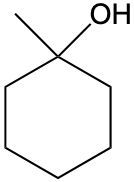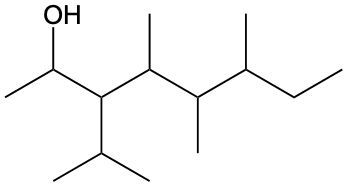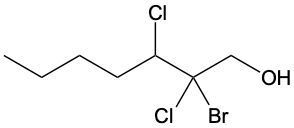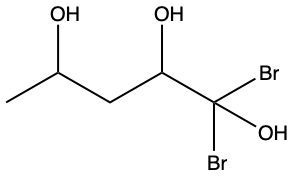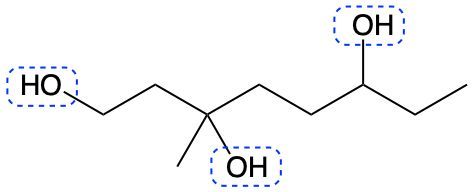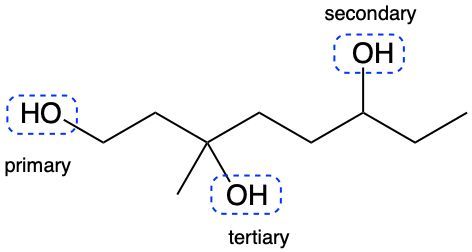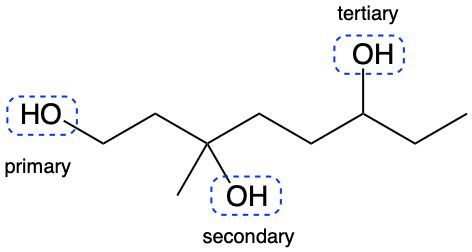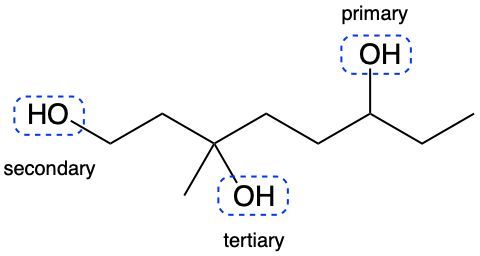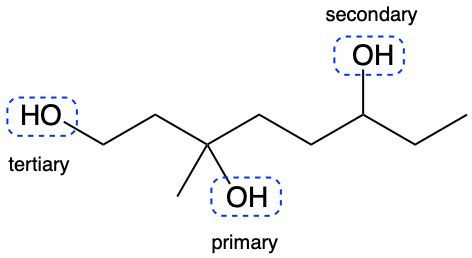Now, before we delve into naming alcohols, recall that alcohols possess a hydroxyl group. The hydroxyl group is the OH group, and it's connected to an sp3 hybridized carbon. Here, the set of rules for naming alcohols are similar to alkanes, plus a modifier ending. Now here, what exactly is a modifier? Well, the modifier is the change to the suffix or ending because of the presence of a functional group. As we go from functional group to functional group, we're going to have different types of modifiers. Now, here for alcohols, the modifier modifies the ending of the alkane name of e to ol. So instead of like pentane, we have pentanol. Here the naming convention is we have to give still the locations of our different substituents, remember those are our branch groups, the location of our parent in terms of our OH group, and then the modification to the ending. In this case, going from an e ending to ol. So keep this in mind when we're naming different types of alcohols.
- 1. Matter and Measurements4h 29m
- What is Chemistry?5m
- The Scientific Method9m
- Classification of Matter16m
- States of Matter8m
- Physical & Chemical Changes19m
- Chemical Properties8m
- Physical Properties5m
- Intensive vs. Extensive Properties13m
- Temperature (Simplified)9m
- Scientific Notation13m
- SI Units (Simplified)5m
- Metric Prefixes24m
- Significant Figures (Simplified)11m
- Significant Figures: Precision in Measurements7m
- Significant Figures: In Calculations19m
- Conversion Factors (Simplified)15m
- Dimensional Analysis22m
- Density12m
- Specific Gravity9m
- Density of Geometric Objects19m
- Density of Non-Geometric Objects9m
- 2. Atoms and the Periodic Table5h 23m
- The Atom (Simplified)9m
- Subatomic Particles (Simplified)12m
- Isotopes17m
- Ions (Simplified)22m
- Atomic Mass (Simplified)17m
- Atomic Mass (Conceptual)12m
- Periodic Table: Element Symbols6m
- Periodic Table: Classifications11m
- Periodic Table: Group Names8m
- Periodic Table: Representative Elements & Transition Metals7m
- Periodic Table: Elemental Forms (Simplified)6m
- Periodic Table: Phases (Simplified)8m
- Law of Definite Proportions9m
- Atomic Theory9m
- Rutherford Gold Foil Experiment9m
- Wavelength and Frequency (Simplified)5m
- Electromagnetic Spectrum (Simplified)11m
- Bohr Model (Simplified)9m
- Emission Spectrum (Simplified)3m
- Electronic Structure4m
- Electronic Structure: Shells5m
- Electronic Structure: Subshells4m
- Electronic Structure: Orbitals11m
- Electronic Structure: Electron Spin3m
- Electronic Structure: Number of Electrons4m
- The Electron Configuration (Simplified)22m
- Electron Arrangements5m
- The Electron Configuration: Condensed4m
- The Electron Configuration: Exceptions (Simplified)12m
- Ions and the Octet Rule9m
- Ions and the Octet Rule (Simplified)8m
- Valence Electrons of Elements (Simplified)5m
- Lewis Dot Symbols (Simplified)7m
- Periodic Trend: Metallic Character4m
- Periodic Trend: Atomic Radius (Simplified)7m
- 3. Ionic Compounds2h 18m
- Periodic Table: Main Group Element Charges12m
- Periodic Table: Transition Metal Charges6m
- Periodic Trend: Ionic Radius (Simplified)5m
- Periodic Trend: Ranking Ionic Radii8m
- Periodic Trend: Ionization Energy (Simplified)9m
- Periodic Trend: Electron Affinity (Simplified)8m
- Ionic Bonding6m
- Naming Monoatomic Cations6m
- Naming Monoatomic Anions5m
- Polyatomic Ions25m
- Naming Ionic Compounds11m
- Writing Formula Units of Ionic Compounds7m
- Naming Ionic Hydrates6m
- Naming Acids18m
- 4. Molecular Compounds2h 18m
- Covalent Bonds6m
- Naming Binary Molecular Compounds6m
- Molecular Models4m
- Bonding Preferences6m
- Lewis Dot Structures: Neutral Compounds (Simplified)8m
- Multiple Bonds4m
- Multiple Bonds (Simplified)6m
- Lewis Dot Structures: Multiple Bonds10m
- Lewis Dot Structures: Ions (Simplified)8m
- Lewis Dot Structures: Exceptions (Simplified)12m
- Resonance Structures (Simplified)5m
- Valence Shell Electron Pair Repulsion Theory (Simplified)4m
- Electron Geometry (Simplified)8m
- Molecular Geometry (Simplified)11m
- Bond Angles (Simplified)11m
- Dipole Moment (Simplified)15m
- Molecular Polarity (Simplified)7m
- 5. Classification & Balancing of Chemical Reactions3h 17m
- Chemical Reaction: Chemical Change5m
- Law of Conservation of Mass5m
- Balancing Chemical Equations (Simplified)13m
- Solubility Rules16m
- Molecular Equations18m
- Types of Chemical Reactions12m
- Complete Ionic Equations18m
- Calculate Oxidation Numbers15m
- Redox Reactions17m
- Spontaneous Redox Reactions8m
- Balancing Redox Reactions: Acidic Solutions17m
- Balancing Redox Reactions: Basic Solutions17m
- Balancing Redox Reactions (Simplified)13m
- Galvanic Cell (Simplified)16m
- 6. Chemical Reactions & Quantities2h 35m
- 7. Energy, Rate and Equilibrium3h 46m
- Nature of Energy6m
- First Law of Thermodynamics7m
- Endothermic & Exothermic Reactions7m
- Bond Energy14m
- Thermochemical Equations12m
- Heat Capacity19m
- Thermal Equilibrium (Simplified)8m
- Hess's Law23m
- Rate of Reaction11m
- Energy Diagrams12m
- Chemical Equilibrium7m
- The Equilibrium Constant14m
- Le Chatelier's Principle23m
- Solubility Product Constant (Ksp)17m
- Spontaneous Reaction10m
- Entropy (Simplified)9m
- Gibbs Free Energy (Simplified)18m
- 8. Gases, Liquids and Solids3h 25m
- Pressure Units6m
- Kinetic Molecular Theory14m
- The Ideal Gas Law18m
- The Ideal Gas Law Derivations13m
- The Ideal Gas Law Applications6m
- Chemistry Gas Laws16m
- Chemistry Gas Laws: Combined Gas Law12m
- Standard Temperature and Pressure14m
- Dalton's Law: Partial Pressure (Simplified)13m
- Gas Stoichiometry18m
- Intermolecular Forces (Simplified)19m
- Intermolecular Forces and Physical Properties11m
- Atomic, Ionic and Molecular Solids10m
- Heating and Cooling Curves30m
- 9. Solutions4h 10m
- Solutions6m
- Solubility and Intermolecular Forces18m
- Solutions: Mass Percent6m
- Percent Concentrations10m
- Molarity18m
- Osmolarity15m
- Parts per Million (ppm)13m
- Solubility: Temperature Effect8m
- Intro to Henry's Law4m
- Henry's Law Calculations12m
- Dilutions12m
- Solution Stoichiometry14m
- Electrolytes (Simplified)13m
- Equivalents11m
- Molality15m
- The Colligative Properties15m
- Boiling Point Elevation16m
- Freezing Point Depression9m
- Osmosis16m
- Osmotic Pressure9m
- 10. Acids and Bases3h 29m
- Acid-Base Introduction11m
- Arrhenius Acid and Base6m
- Bronsted Lowry Acid and Base18m
- Acid and Base Strength17m
- Ka and Kb12m
- The pH Scale19m
- Auto-Ionization9m
- pH of Strong Acids and Bases9m
- Acid-Base Equivalents14m
- Acid-Base Reactions7m
- Gas Evolution Equations (Simplified)6m
- Ionic Salts (Simplified)23m
- Buffers25m
- Henderson-Hasselbalch Equation16m
- Strong Acid Strong Base Titrations (Simplified)10m
- 11. Nuclear Chemistry56m
- BONUS: Lab Techniques and Procedures1h 38m
- BONUS: Mathematical Operations and Functions47m
- 12. Introduction to Organic Chemistry1h 34m
- 13. Alkenes, Alkynes, and Aromatic Compounds2h 12m
- 14. Compounds with Oxygen or Sulfur1h 6m
- 15. Aldehydes and Ketones1h 1m
- 16. Carboxylic Acids and Their Derivatives1h 11m
- 17. Amines38m
- 18. Amino Acids and Proteins1h 51m
- 19. Enzymes1h 37m
- 20. Carbohydrates1h 46m
- Intro to Carbohydrates4m
- Classification of Carbohydrates4m
- Fischer Projections4m
- Enantiomers vs Diastereomers8m
- D vs L Enantiomers8m
- Cyclic Hemiacetals8m
- Intro to Haworth Projections4m
- Cyclic Structures of Monosaccharides11m
- Mutarotation4m
- Reduction of Monosaccharides10m
- Oxidation of Monosaccharides7m
- Glycosidic Linkage14m
- Disaccharides7m
- Polysaccharides7m
- 21. The Generation of Biochemical Energy2h 8m
- 22. Carbohydrate Metabolism2h 22m
- 23. Lipids2h 26m
- Intro to Lipids6m
- Fatty Acids25m
- Physical Properties of Fatty Acids6m
- Waxes4m
- Triacylglycerols12m
- Triacylglycerol Reactions: Hydrogenation8m
- Triacylglycerol Reactions: Hydrolysis13m
- Triacylglycerol Reactions: Oxidation7m
- Glycerophospholipids15m
- Sphingomyelins13m
- Steroids15m
- Cell Membranes7m
- Membrane Transport10m
- 24. Lipid Metabolism1h 45m
- 25. Protein and Amino Acid Metabolism1h 37m
- 26. Nucleic Acids and Protein Synthesis2h 54m
- Intro to Nucleic Acids4m
- Nitrogenous Bases16m
- Nucleoside and Nucleotide Formation9m
- Naming Nucleosides and Nucleotides13m
- Phosphodiester Bond Formation7m
- Primary Structure of Nucleic Acids11m
- Base Pairing10m
- DNA Double Helix6m
- Intro to DNA Replication20m
- Steps of DNA Replication11m
- Types of RNA10m
- Overview of Protein Synthesis4m
- Transcription: mRNA Synthesis9m
- Processing of pre-mRNA5m
- The Genetic Code6m
- Introduction to Translation7m
- Translation: Protein Synthesis18m
Naming Alcohols - Online Tutor, Practice Problems & Exam Prep
 Created using AI
Created using AIAlcohols are organic compounds characterized by the presence of a hydroxyl group (–OH) attached to an sp3 hybridized carbon. They are named by modifying the alkane name, replacing the suffix "e" with "ol" (e.g., pentane becomes pentanol). Alcohols can be classified as primary, secondary, or tertiary based on the number of carbon groups attached to the carbon bearing the hydroxyl group. Understanding these classifications is essential for proper naming and recognizing the structure of alcohols in organic chemistry.
Rules for Naming Alcohols Concept 1
Video transcript
Naming Alcohols Example 1
Video transcript
Here in this example question, it says, "Name the following alcohol compound." Alright. So, we're going to use the following steps in order to name this particular alcohol. Here, step 1 says that we have to find the longest carbon chain. That longest carbon chain represents our parent chain. And we're going to assign a name according to the prefixes and now modifier. Now, the parent chain should include the OH group, since we're talking about an alcohol, and have the greatest number of carbons. Now, if a tie exists between the longest chains, choose the chain with more substituents. This one is pretty straightforward. Our longest chain we can see is this portion right here, and we can see that the OH and the Cls act as our substituents. So this leads us into step 2, assign a name to all the substituents. Alright. So here our chlorines would be chloro. The alcohol itself is going to be a modifier, so we don't have to name it here. Next, we're going to say start numbering the chain from the end closest to the OH group. If a tie, number from the end closest to the next substituent. If still a tie, number in alphabetical order. Now, assign the numerical location to the carbon with the OH group. So here we've identified the two substituents in terms of chlorine, we've looked at the longest chain, we know that OH is going to be our functional group that's going to modify the end of the name. So here, I've already numbered the chain for us. We're numbering it from this end 1 because, going 1, 2, we get to our first substituent. If we had numbered it from the other end, it would take us 1, 2, 3 before we get to a substituent. That takes too long. Alright. So now, let's finally name this. We're going to say here that a 6 carbon chain is hexane, but remember the presence of the OH changes the ending from 'e' to 'ol,' so it becomes hexanol. We have to state on what carbon the OH is for the alcohol; it's on carbon 3, so this would be 3-hexanol. Remember, we use a dash to separate numbers from letters. Next, we said that these chlorines are chloro, there are two of them, so that would be dichloro. And finally, we have to state on what carbons those two chlorines are found. They're found on carbons number 2 and 4. So this would be 2,4-dichloro-3-hexanol. So "2,4-dichloro-3-hexanol" will be the name of this particular alcohol compound.
Provide the systematic name for the following alcohol.
1-methyl-1-hydroxycyclohexane
1-methylcyclohexanol
1-methyl-1-hydroxyhexane
1-methylhexanol
Provide the formal name for the following alcohol.
3-isopropyl-4,5,6-trimethyloctanol
2-isopropyl-1,3,4,5-tetramethylheptanol
3-isopropyl-4,5,6-trimethyl-2-octanol
6-isopropyl-3,4,5-trimethyl-2-octanol
Which structure represents 2-bromo-2,3-dichloro-1-heptanol?
Name the following dialcohol.
hexane-3,6-diol
hexane-3,6-ol
heptane-3,6-diol
heptane-2,5-diol
Provide IUPAC name for the following trialcohol.
1,1-dibromohexane-1,3,5-triol
1,1-dibromopentane-1,2,4-triol
1,1-dibromopentane-2,4-diol
5,5-dibromopentane-2,4,5-triol
Alcohol Classification Concept 2
Video transcript
Alcohols can be classified based on how many carbon groups are attached to the OH-bearing carbon atom. So here we have classifications of primary, which is 1º, secondary, which is 2º, and tertiary which is 3º. If we take a look here at the first one, we have a carbon with our OH group. We'd say that the carbon with the OH group, let's say it's connected to just one carbon here. That would mean that this is a primary alcohol. Now, here let's put 2 carbons. So now that the carbon that bears the OH group is connected to 2 carbons, it's secondary. And then finally, we can say in this last image, the carbon possessing the OH group, it's directly connected to 3 carbons, meaning that it is a tertiary alcohol. So, remember, in our exploration to name different types of alcohols, you're going to come into contact with primary, secondary, tertiary alcohols, including also methyl alcohols, which don't belong to any of these categories. Right? So just keep this in mind when looking at different types of alcohols.
Alcohol Classification Example 2
Video transcript
Here it says that we need to classify the following alcohols. So let's look to see where is the carbon with the OH group. So here's the carbon with the OH group, and here's the carbon with the OH group. In the first image, that carbon possessing the OH group is connected to 2 other carbons which we don't see, here and here. Since it's connected directly to 2 carbons, it is a secondary alcohol. And then for this other one, this carbon with the OH group, it is directly connected to 1 carbon here. So here it's connected directly to one carbon, so this would represent a primary alcohol. The first compound is secondary, and the second one here is primary.
Label each alcohol as primary, secondary, or tertiary.
Do you want more practice?
Here’s what students ask on this topic:
What is the general rule for naming alcohols in organic chemistry?
In organic chemistry, alcohols are named by modifying the name of the parent alkane. The suffix 'e' in the alkane name is replaced with 'ol'. For example, 'pentane' becomes 'pentanol'. Additionally, the position of the hydroxyl group (–OH) must be indicated by a number placed before the name. For instance, if the hydroxyl group is on the second carbon of pentane, it is named '2-pentanol'. The numbering of the carbon chain should start from the end nearest to the hydroxyl group to give it the lowest possible number.
 Created using AI
Created using AIHow are primary, secondary, and tertiary alcohols classified?
Alcohols are classified based on the number of carbon groups attached to the carbon bearing the hydroxyl group (–OH). A primary alcohol has the hydroxyl-bearing carbon attached to only one other carbon (e.g., ethanol). A secondary alcohol has the hydroxyl-bearing carbon attached to two other carbons (e.g., isopropanol). A tertiary alcohol has the hydroxyl-bearing carbon attached to three other carbons (e.g., tert-butanol). This classification helps in understanding the reactivity and properties of different alcohols.
 Created using AI
Created using AIWhat is the significance of the hydroxyl group in alcohols?
The hydroxyl group (–OH) is the defining feature of alcohols and significantly influences their chemical properties. It is attached to an sp3 hybridized carbon. The presence of the hydroxyl group makes alcohols polar, which affects their solubility in water and their boiling points. The hydroxyl group also participates in hydrogen bonding, which further influences the physical properties of alcohols. Additionally, the hydroxyl group is reactive and can undergo various chemical reactions, making alcohols important intermediates in organic synthesis.
 Created using AI
Created using AIWhy is it important to indicate the position of the hydroxyl group in alcohol nomenclature?
Indicating the position of the hydroxyl group in alcohol nomenclature is crucial because it determines the specific structure and properties of the alcohol. Different positions of the hydroxyl group can result in different compounds with distinct chemical and physical properties. For example, 1-propanol and 2-propanol (isopropanol) are both alcohols with three carbon atoms, but their properties differ due to the position of the hydroxyl group. Properly indicating the position ensures clear communication and accurate identification of the compound.
 Created using AI
Created using AIHow does the presence of a hydroxyl group affect the physical properties of alcohols?
The presence of a hydroxyl group (–OH) in alcohols significantly affects their physical properties. The hydroxyl group is polar and can form hydrogen bonds with water molecules, making many alcohols soluble in water. This solubility decreases as the carbon chain length increases. The ability to form hydrogen bonds also raises the boiling points of alcohols compared to hydrocarbons of similar molecular weight. For example, ethanol has a higher boiling point than ethane due to hydrogen bonding. These properties are essential for understanding the behavior of alcohols in various chemical and biological contexts.
 Created using AI
Created using AIYour GOB Chemistry tutor
- Name the following compounds:a. <IMAGE>b. <IMAGE>
- Draw structures for the following:a. 2,4-Dinitrophenolb. m-Ethylphenol
- Draw structures corresponding to the following names:b. 2,2-Diethylcyclohexanol
- Draw structures corresponding to the following names:a. 2,4-Dimethyl-2-heptanol
- Draw all possible cyclic C₇H₁₄O alcohol isomers having a cyclohexane ring and a methyl group. (Hint: Adapt the...
- Name the following compounds:c. <IMAGE>d. <IMAGE>
- a. Identify each alcohol named in Problem 14.32 as primary, secondary, or tertiary.
- Draw structures corresponding to the following names:e. 2,4-Dimethoxy-3-methylpentane
- Draw structures corresponding to the following names:f. 3,3-Dimethyl-1,6-heptanediol
- Write the formulas and IUPAC names for the following common alcohols (Hint: See Table 14.1).a. Rubbing alcohol
- Name the following compounds:a. <IMAGE>b. <IMAGE>c. <IMAGE>
- Give the IUPAC name for each of the following:d. <IMAGE>
- Give the IUPAC name for each of the following:b. <IMAGE>
- Give the IUPAC name for each of the following alcohols and phenols: (12.1)a. <IMAGE>
- Draw the condensed structural formula, or line-angle formula if cyclic, for each of the following:d. 4-bromoph...
- Classify each of the following alcohols as primary (1°), secondary (2°), or tertiary (3°):a. <IMAGE>
- Write the balanced chemical equation for the complete combustion of each of the following compounds:b. 3-hexan...
- Draw the condensed structural or line-angle formula for each of the following: (12.1)b. 2-methyl-3-pentanol
- Draw the condensed structural or line-angle formula for each of the following: (12.1)d. 2,4-dibromophenol
- Draw the condensed structural formulas and give the IUPAC names for all the alcohols that have the formula C₅H...
- Classify each of the following alcohols as primary (1°), secondary (2°), or tertiary (3°):c. <IMAGE>
- Classify each of the following alcohols as primary (1°), secondary (2°), or tertiary (3°):d. <IMAGE>
- Draw the condensed structural formula, or line-angle formula if cyclic, for each of the following:c. 2-methyl-...
- Classify each of the following alcohols as primary (1°), secondary (2°), or tertiary (3°):d. <IMAGE>
- Give the IUPAC name for each of the following alcohols and phenols: (12.1)c. <IMAGE>
- Give the IUPAC name for each of the following alcohols and phenols: (12.1)b. <IMAGE>
- Give the IUPAC name for each of the following alcohols and phenols: (12.1)c. <IMAGE>
- Are each of the following soluble, slightly soluble, or insoluble in water? Explain.a. CH₃—CH₂—CH₂—OH
